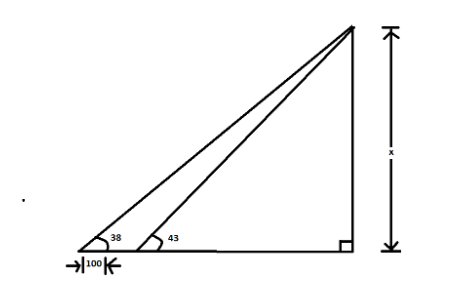
How do you determine the length of \[x\] in a right triangle when some of the information given is not part of the right triangle in question, but instead part of an outside acute angle?
Answer
519.6k+ views
Hint: In order to find the solution to the question given above, we use the Law of Sines. It is a relationship between the sides and the angles of an oblique triangle. According to it, the ratio of the length of a side of a triangle to the sine of the angle opposite that side is the same for all the angles and sides in a given triangle.
Formula used:
Law of Sines: \[\dfrac{{sinA}}{a} = \dfrac{{\sin B}}{b} = \dfrac{{\sin C}}{c}\]
Complete step by step solution:

Let the angle at the left-hand side of the \[43^\circ \] , directly over the hypotenuse be \[\alpha \] . It is a supplementary angle. We get,
\[\alpha = 180^\circ - 43^\circ \]
\[ = 137^\circ \] .
Now, in the oblique triangle, let the last unknown triangle be \[\theta \] .
Now, we know that in a triangle, the angles are always complementary, so,
\[\theta = 180^\circ - 38^\circ - 137^\circ \]
\[ = 5^\circ \] .
Now, to determine the length of the hypotenuse of the right triangle, we will use the Law of Sines.
According to this, let the hypotenuse of the right triangle be \[b\] .
\[\dfrac{{sinA}}{a} = \dfrac{{\sin B}}{b}\]
On equating the values, we get,
Now, cross multiple the above equation.
We get,
\[b = \dfrac{{100\sin 38^\circ }}{{\sin 5^\circ }}\]
Now, we can set up our ratio. We now can determine the length of \[x\] which is opposite to the known angle \[43^\circ \] . We will use the sine ratio since we know the measure of hypotenuse.
\[\dfrac{x}{{\dfrac{{100\sin 38^\circ }}{{\sin 5^\circ }}}} = \dfrac{{\sin 43^\circ }}{1}\]
So, we get that \[x = 481.76\] units.
Our final answer is \[x = 481.76\] units.
So, the correct answer is “ \[x = 481.76\] units”.
Note: While solving questions similar to the one given above, always remember to use the Law of Sines. With the help of this law you can easily solve the question in no time. The formula for the Law of sines is: \[\dfrac{{sinA}}{a} = \dfrac{{\sin B}}{b} = \dfrac{{\sin C}}{c}\] , where \[A,B\] and \[C\] are the angles respectively and \[a,b\] and \[c\] are the respective sides.
Formula used:
Law of Sines: \[\dfrac{{sinA}}{a} = \dfrac{{\sin B}}{b} = \dfrac{{\sin C}}{c}\]
Complete step by step solution:

Let the angle at the left-hand side of the \[43^\circ \] , directly over the hypotenuse be \[\alpha \] . It is a supplementary angle. We get,
\[\alpha = 180^\circ - 43^\circ \]
\[ = 137^\circ \] .
Now, in the oblique triangle, let the last unknown triangle be \[\theta \] .
Now, we know that in a triangle, the angles are always complementary, so,
\[\theta = 180^\circ - 38^\circ - 137^\circ \]
\[ = 5^\circ \] .
Now, to determine the length of the hypotenuse of the right triangle, we will use the Law of Sines.
According to this, let the hypotenuse of the right triangle be \[b\] .
\[\dfrac{{sinA}}{a} = \dfrac{{\sin B}}{b}\]
On equating the values, we get,
Now, cross multiple the above equation.
We get,
\[b = \dfrac{{100\sin 38^\circ }}{{\sin 5^\circ }}\]
Now, we can set up our ratio. We now can determine the length of \[x\] which is opposite to the known angle \[43^\circ \] . We will use the sine ratio since we know the measure of hypotenuse.
\[\dfrac{x}{{\dfrac{{100\sin 38^\circ }}{{\sin 5^\circ }}}} = \dfrac{{\sin 43^\circ }}{1}\]
So, we get that \[x = 481.76\] units.
Our final answer is \[x = 481.76\] units.
So, the correct answer is “ \[x = 481.76\] units”.
Note: While solving questions similar to the one given above, always remember to use the Law of Sines. With the help of this law you can easily solve the question in no time. The formula for the Law of sines is: \[\dfrac{{sinA}}{a} = \dfrac{{\sin B}}{b} = \dfrac{{\sin C}}{c}\] , where \[A,B\] and \[C\] are the angles respectively and \[a,b\] and \[c\] are the respective sides.
Recently Updated Pages
Why are manures considered better than fertilizers class 11 biology CBSE

Find the coordinates of the midpoint of the line segment class 11 maths CBSE

Distinguish between static friction limiting friction class 11 physics CBSE

The Chairman of the constituent Assembly was A Jawaharlal class 11 social science CBSE

The first National Commission on Labour NCL submitted class 11 social science CBSE

Number of all subshell of n + l 7 is A 4 B 5 C 6 D class 11 chemistry CBSE

Trending doubts
What is meant by exothermic and endothermic reactions class 11 chemistry CBSE

10 examples of friction in our daily life

One Metric ton is equal to kg A 10000 B 1000 C 100 class 11 physics CBSE

1 Quintal is equal to a 110 kg b 10 kg c 100kg d 1000 class 11 physics CBSE

Difference Between Prokaryotic Cells and Eukaryotic Cells

What are Quantum numbers Explain the quantum number class 11 chemistry CBSE




